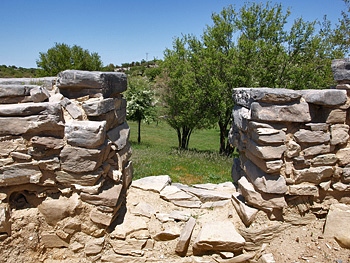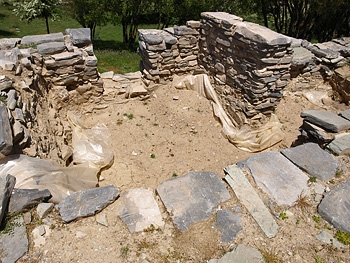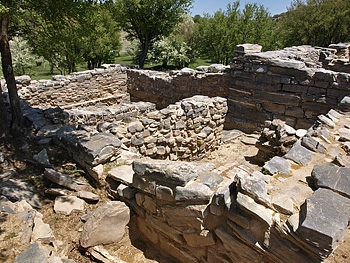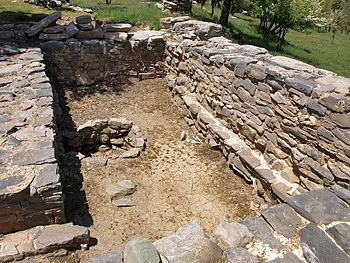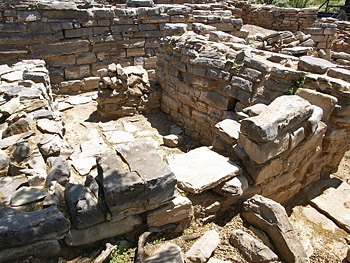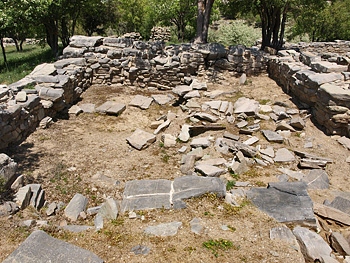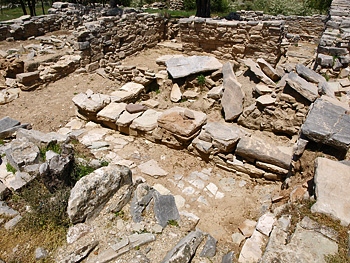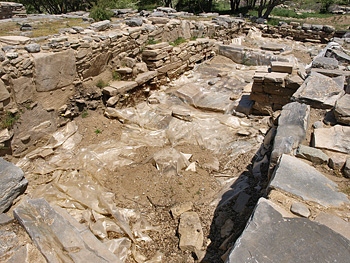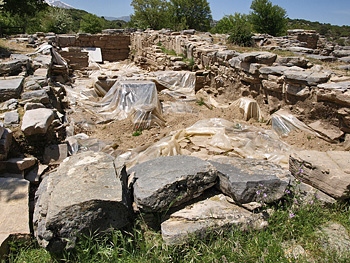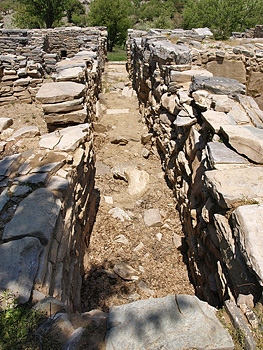Zominthos
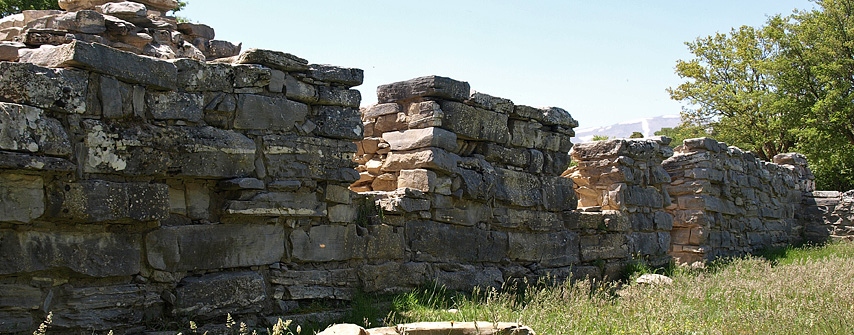
Zominthos (the name has pre-Greek origins) is situated 1187 metres above sea level on a small plain with plentiful supplies of water. In the 17th century BCE there was already an extensive settlement and a monumental neopalatial central building of 1600 square metres here. Beneath the northwest wing of the neopalatial building remains of a building from an earlier period were discovered.
It is speculated that given the winter weather conditions at this height the building may not have been in use all year round but was used as seasonal accommodation during the summer months when flocks of sheep were taken to higher levels for grazing.
The site was discovered in 1982 and Yiannis Sakellarakis began excavations over a limited area the following year. The first period of excavations lasted until 1990. After a gap of fourteen years it was decided in 2004 to continue. Yiannis Sakellarakis led the excavations up to his death in 2010. Excavations at the site are still ongoing,
The first year of actual excavations in 1983 resulted in the discovery of the LM IA building which dominates one of the main Minoan routes towards Psiloritis and which could have also been used as a stopping off point by visitors heading from Knossos to the Idaean cave near the summit of the mountain. The central building was part of a larger settlement which covered at least 3,000 square metres (0.4 hectares) plus a cemetery.
The Central Building
The central building is remarkably well preserved, with some walls standing as high as 2.20 metres. It represents the largest Minoan country house found so far. Consequently the excavator posits the likelihood of a central authority wishing to control the flocks and grazing areas in this part of Crete.
The building was most likely an industrial, religious and administrative centre, built at a strategically important place for the monitoring of the area. It is possible that the rich grazing lands of Zominthos and the surrounding area together with their flocks of sheep are mentioned in the Linear B tablets found at Knossos since some of these tablets contain lists of flocks and grazing areas. This would help to explain the palatial characteristics of the central building, which include a strict north-south orientation, an impressive size (54 metres by 37 metres) and an asymmetrical facade.
The Central Building was destroyed by an earthquake, most likely followed by fire, still in the LM I period and was completely abandoned. Nevertheless the general area continued in use throughout subsequent historic periods down to and including the Romans. Today only the ground floor of the Central Building remains. It was at least a two-storey building built with large stones of limestone rock and at least some rooms seem to have been plastered and decorated with wall paintings. Fewer than half of the over 50 rooms on the ground floor have been partly or completely excavated. Some water pipes were also discovered, attesting to the probability of a drainage system.
The rooms of the North Facade
The entrance to the central building was in the north facade. A corridor to the west of room 9 (area 10) led to the south wing of the building. The north entrance and the two windows on the north walls of rooms 8 and 9 make this one of the best preserved facades in the whole of Minoan Crete. Inside these rooms evidence of painted plaster was found as well as remains of animal bones and carbonised wood.
Room 9 is ten square metres in size and it communicated with rooms 7 and 8 through an opening at the southeast corner of the room. Among the finds in room 9 were sherds, fragments of animal bones and pieces of carbonised wood. A large quantity of plaster fragments has been found here too. Many of the pieces have been coloured red, orange or black. In some cases, bands of different colors alternate with each other. Also discovered in the northeast corner of the room was a rectangular stone structure. There was also an opening which gave access to the room from Corridor 10. At some later phase this opening had been blocked up.
In room 8, as the excavation proceeded, increasing amounts of painted plaster fragments were found. A large variety of colours were used, mainly red but also orange, yellow, gray and black. In one part of the room the red and black colours on the plaster fragments were separated by bands of white. On the western section of the south wall, excavators discovered a course of upright limestone stones in the form of a semicircle. Although they are certain that these stones were deliberately placed there to create a structure, they have been unable to identify what it was. The structure was eventually removed from the room.
Room 7, also on the north facade, had a paved floor. The room contained a thick layer of plaster, larger than any other piece to have been recovered in Minoan Crete. When it was moved, remains of the flooring from the upper floor were discovered beneath it so it seems that the plaster actually covered the floor of the upper storey. Large quantities of painted plaster fragments have been recovered from room 7. The main colours used in painting seem to have been blue, black and red.
In room 6, immediately south of room 7, traces of red and blue colouring on plaster were revealed. The discovery of painted plaster here and in other parts of the Central Building confirm that parts of the Central Building had been decorated with frescos.
The Ceramic Workshop
In the western section of the central building an outbuilding which had housed a ceramic workshop was found. This had been constructed later than the Central Building itself, even though the Central Building can be accessed from the Workshop rooms (13, 14, 15) along corridor 16, which was originally paved. In fact, two thresholds and 28 limestone slabs were uncovered in the corridor.
Rooms 13-15, which communicated with each other via corridor 16, were identified as a pottery workshop by the large number of pottery vessels which were discovered here. In room 13 alone, more than 250 vessels were found, both fallen from wooden shelves as suggested by burnt wood beneath many of the ceramic objects but also placed on two stone benches which ran the length of the north and south walls. The finds here included a circular water tank used for cleaning the clay, a potter's wheel, stone, bone and bronze tools and rocks of quartz crystal. The potter's wheel, which was typical of those in use during the Neopalatial period, was one of the largest of its type to be found.
Outside the Central Building, a short distance from the north wall of the ceramic workshop, remains were found which are believed to be the kiln where the pottery was fired. Unfortunately room 14, directly south of room 13, did not provide any evidence linking it with the production of pottery even though it seems likely that at least one wall was lined with a bench. Consequently it remains unkown whether the room was used in some way connected with the work in room 13. In rooms 14 and 15 the walls stand high enough for the placing of a window in the east wall of each room to be apparent.
Room 15 is the southernmost of the three rooms in the Ceramics Workshop outbuilding. Unlike room 14 to the north, room 15 yielded a large quantity of pottery vessels. These included the usual handleless cups as well as cylindrical and spouted cups, cooking pots, kalathoi, jars, lamps, beaked jugs, various lids and pithoi. All these objects dated to the Late Minoan IA period. The excavators concluded that due to the number and variety of vessels, their positioning, and the discovery of grinders and obsidian, that this room had been used as a workshop.
The discovery of pottery vessels in a layer two metres above the actual floor of room 15 indicates that there would have been an upper floor to this outhouse as well. An enormous pithos nearly four feet high was discovered in the eastern part of the room, covered by parts of the floor fallen from above. Also found were the usual animal bones, burnt wood and fragments of white plaster. An incense burner and a lamp were also found.
Two niches were discovered in room 15. In one of them three high quality cups decorated with a floral pattern were found. They had high stems and a hole in the bottom which means that they were used as rhyta in cult ceremonies, testifying to a possible religious role for the complex alongside the manufacturing role already established. Two basins, unique to Zominthos, which are thought to have been used in feeding animals were also uncovered.
Further evidence that room 15 was a workshop came from the presence of a large quantity of quartz crystals, suggesting that the processing of quartz was a major activity carried out in this workshop. Offerings made of quartz have been found at several peak sanctuaries as well as in the nearby Idaean Cave and being a relatively precious mineral may have been used in Minoan cult rituals.
Also supporting the idea that room 15 was a workshop was the discovery of manganese oxide in the form of pyroluzit. This would have been imported from Lavrio on mainland Greece or from the island of Melos. It was used to produce certain colours.
When corridor 16 was re-excavated in 2006 it was found to contain a small niche containing a beaker jug and three incense burners among other finds.
The kitchen
Room 17, south east of the Ceramic Workshop, provided further evidence of the existence of a second floor in the form of a large quantity of red and green schist slabs which had formed part of the flooring of the upper floor and had fallen in during the destruction. In room 17 various objects were found either at the level of the original floor or some 20-30 centimetres above floor level and these were objects that had either fallen from shelves in the room or from the upper floor during the destruction.
About 70 vessels were found at floor level in room 17. Most of them consisted of handleless conical cups as well as smaller quantities of cooking pots and dishes. At several points in the room carbonised wood and animal bones were discovered and there is some evidence that there may have been a hearth in the room. A low bench may have been in place along the west wall. In the east part of the room a pithos and the remains of a second pithos were found. Excavators have concluded that the room was most likely used in the preparation of food.
The discovery of a large number of vessels dating to later periods in this area of the building, including room 17, led the excavators to the conclusion that the ruins of the Central Building must have been clearly visible for some time after its destruction, which is not surprising given its fine state of preservation 3,500 years later. They further believe that even if the building was not reinhabited on a permanent basis, it may have been at this time that pilgrims to the Idaean cave used the building as a stopover.
Rooms19/28 -- interesting finds
Room 19 and room 28 which lies immediately to its south seem to have been subjected to some looting in the past, making an understanding of the area more difficult today. Close to the south wall of room 15, in room 19, interesting finds included a loomweight, a grinder, a bronze knife and an awl. Other interesting finds from room 19 include a seal showing a scorpion and two stone grinders.
In Room 28 a large staircase was uncovered and the room seems to have contained a hearth. Among the more interesting finds in the room, which was paved, were a brazier and a steatite seal showing a lion. In the southeast corner of the room there are two openings, one of which leads into room 26. One of the major finds in room 28, up against the east wall, was a bronze male adorant figurine with locks of hair and a dress. Other finds included the horn of a big animal, a sherd decorated with bands and spirals -- probably from a chalice used in rituals, a big quern stone, a stone grinder, an agate bead and a bronze pin.
Close to rooms 19/28 is another room, Area 26, which on investigation turned out to be two separate areas so the excavators had to give the new area the number 53. Area 53 is along, narrow room, most likely a corridor. It links Area 19/28 with the storage rooms 11 and 12 and, via the staircase in Area 20, with the upper floor.
It was possible to communicate between rooms 26 and 53 through an opening in the wall. Where this opening is located, three fruit stands, possibly involved in ritual activity, were found. Also found in this area was a bronze cup. There were three incisions on the handle and three rivets.
The Minoan Hall
Room 29 lies some metres south of the north facade. It is a long, narrow room, about 20m. long and 6.5m. wide and it proved to be one of the most interesting rooms excavated to date. Three walls divided the room into four separate small areas. These walls date to a much later period and given the presence of objects from the Roman period in the room, they have now been assigned by excavators to the Roman period. So amazingly it seems that one and a half millenia after its destruction the Romans used room 29 and built extra internal walls to divide it up into smaller areas.
There are also a number of other walls and parts of walls making the picture considerably more complex. The four areas were named sectors I-IV. In sector II the remains of a Roman hearth were found. This was removed along with the three Roman walls in order to enable the excavators to better understand the Minoan levels beneath. Unfortunately sectors III and IV had been badly disturbed with the result that pottery from very different periods was appearing at the same levels.
Nevertheless it was possible to discern four periods of occupation in Room 29. These were as follows:
i. Late into the protopalatial period (MM II)
ii. The beginning of the Neopalatial period (MM III)
iii. The mature Neopalatial period (LM IA)
iv. The Roman period.
Two important discoveries were made at the Minoan levels in area IV. Firstly, a circular hearth with a diameter of about 1.30m was discoved. The hearth was made of dressed stones and clay bricks engraved with a spiral decoration.
Even more importantly, the excavators discovered the stone base of a column half a metre wide together with a large quantity of wood which may actually have come from the wooden pillar itself. By the west wall the remains of what might have been a bench was found.
The discovery of this column base together with the discovery of another one in room 30, adjacent to room 29, meant that a covered courtyard almost certainly existed here. Eventually a huge threshold and two pilasters indicating a great opening to the west side of this room were uncovered. It was felt that this opening was a pier-and-door partition. As the excavations continued the excavators came to the conclusion that at some point there had been a Minoan Hall here.
Room 50
Excavation of Room 50 only began in 2012 and is still in its early stages. The room belongs to the earliest construction phase of the building. The room contained fallen pieces of plaster which had originally covered the west wall. In the south half of the room a plaster-covered bench was uncovered. The room was also discovered to have a paved floor, a column base and a hearth. It will be interesting to see what else we learn about what must surely be an important room.
Buildings west of the Ceramic workshop
Geomagnetic prospection revealed the presence of underground walls to the west of the ceramic workshop and north of room 17. In 2011, excavators began to uncover these walls and came across a dense concentration of pottery vessels with charcoal and animal bones in the same area, leading to a tentative conclusion that this may have been an area of food preparation and/or consumption. However, excavation of this area was not continued in 2012.
Modern technology at Zominthos
Apart from geomagnetic prospection other modern technologies are being used at the Zominothos excavation, in particular 3D capturing methodologies involving the use of a laser scanner, which will permit 3D modelling of excavated areas. This technique is being used in rooms 19/28 and rooms 8 and 9.
Zominthos is the first Greek excavation where excavators use a wearable camera to making live recordings of aspects of the excavation. By mounting the tiny camera on the ear, what the excavator is looking at and doing can now be filmed.
Another first for the Zominthos excavation is the use of highlight RTI image capture to obtain details of an object's surface shape based on the interaction of a light source and the object. This is particularly useful when the object under examination is no longer in good condition. While the object to be examined and the camera are held still, the angle and position of the light source is varied. Software is then used to enhance the image.
SOURCES: This text is based on information obtained from the Greek-language website "Excavation at Zominthos on Psiloritis", from official reports on the excavation and from the Interactive Dig website dedicated to the Zominthos project. This contains a chronological account of each year's excavation activity so you can experience the developments in the same way as the excavators did. The entries are illustrated with lots of photos and maps and they have begun to add video clips as well. There is a link to the website on the resources page.
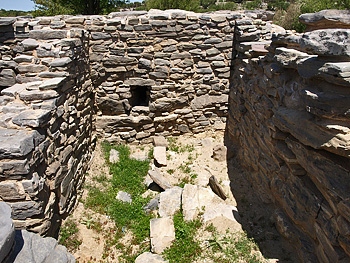 Room 11 |
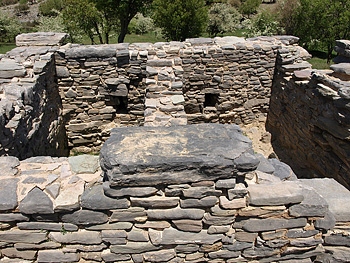 Rooms 11 and 12 |

